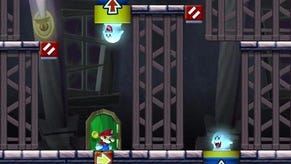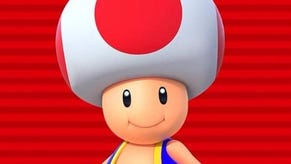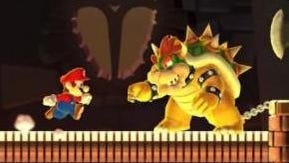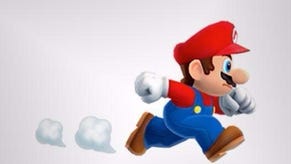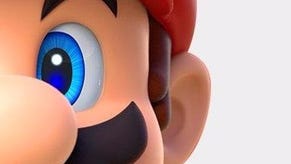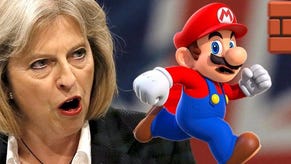Super Mario Run review
Dial M for Mario.
Is it a spoiler to say there are ghost houses in Super Mario Run? If so, my apologies. Consider yourself spoiled. And yet, because this is Mario - and because these are ghost houses - the spoiler does not really spoil very much. I only mention the ghost houses at all because the first one - level 2-1 - was the moment at which I first sat up and started really paying attention. It's the first level where you glimpse once again what makes Mario special: not that he basically invented the trappings of the platformer, to the extent that playing through the opening few levels of his new iPhone autorunner puts you into a kind of cognitive tailspin as you realise how much it reminds you of all other iPhone autorunners and, in turn, how much all other iPhone autorunners remind you of Mario. What makes Mario special is that, even deep within the clutch of genre conventions that he created - a clutch so few perfectly good games ever escape from - he wriggles free and shows you something new.
The best example of this sort of thing - other than 2-1, which I'm going to get to in a minute - comes in one of the New Super Mario games for the 3DS, a series that Super Mario Run takes many of its cues from. I can't remember which of the old New games I'm thinking of, and that's probably part of the point. Anyway, Mario's travelling upwards inside a Koopa castle of some kind, stuck on an elevator that rises through a tower, passing coins, passing platforms, passing enemies. And then a spiked boulder falls onto the screen from the left. It rolls towards Mario. You jump. He jumps. And then it rolls off the right-hand side of the screen. Phew!
Except because this world wraps left-to-right, the boulder's back. It rolls in again. Mario jumps again. And then it disappears again. And then it returns again. This is the gimmick of this level: a boulder, an elevator, an old trick of platformers where every exit stage right is an entrance stage left. Mario, this late in his career, still has the imagination to turn all this into a sort of perpetual motion machine. The boulder keeps rolling through the hard interior of the Mario Pinball table you're apparently stuck in, the passing level furniture making each new journey it takes fresh and surprising and playful.
So, really, wringing a ghost house from this kind of set-up is no big deal.
Until 2-1, Super Mario Run felt constricted to me. A side-scrolling autorunner in which your only real control of Mario is to tell him to jump - and, measured by how long you touch the screen with your finger, to tell him how high to jump. It's weird with Mario to have most basic freedom of movement removed. It's weird that the screen is set to portrait rather than landscape, too, so that your view of the road ahead is limited.
And then 2-1, and it all clicks. That jump? That jump counts for far more than it usually does in Mario. Crazy as it sounds, it's grown in range and scope as a traversal option, encouraging you to view each level as a stack of tiers you must move between to avoid dangers, to snag the best trinkets. And the portrait orientation? It's working double-time for you. It's enforcing a kind of attentiveness, as you react to things that are flung at you with little notice, and it's also - this is brilliant - allowing for moments when the world wraps around left to right, and you're not so much moving from one side of the screen as you are from the bottom to the top.
2-1. A ghost house. A screen filled with platforms at different heights, doors on different platforms, and jump pads to send you up and down. Go to the right, reappear at the left, and none of the doors seem to actually take you somewhere new. How do you get out of this mess? You start by playing with the level's height, with the jump pad's willingness to deposit you at different elevations, at which point Mario's autorunning becomes a kind of programming challenge in which you can pretty much work out where you're going to drop from one platform to the next, and then reverse-engineer the moves you need to make to get to the places you want to visit. Mario often feels like a timeline in these 2D games, sweeping across beautifully choreographed worlds, triggering the things around him and bringing them to life as he goes. That's never been truer than it is here: Mario is moving, and rather than control him in the traditional sense, you have to keep up with him and make the most of his pathfinding.
Again and again, Super Mario Run surprises you in interesting technical ways. More than any Mario in memory, it's very clearly two different games folded into one. (This split personality is always present, but here it's really, really obvious.) The first game is the breezy throwback platformer even a lapsed fan can race through in a single lazy morning. 24 short stages, four of which are available for free, the rest of which come with a simple one-off payment of £7.99 - and that's all you'll be spending on this game as far as I can tell. The stages are filled with familiar sights - deserts, mushroom mountains, floating pirate ship armadas - and they refuse to outstay their welcome, 100 seconds on the clock most of the time, with double-speed audio clicking in for the last 10 seconds alone. There are a few new moves - mantling is new, as is a mid-air brake sort of deal that allows you to lose momentum and pick a landing spot - and there are a few new blocks. Pause blocks to give you a breath, extra time blocks to give you a few extra seconds. Nothing special. Grab coins, jump on enemies (there's a neat twist here, in that you'll typically vault over foes automatically now, so you need to jump again at just the right moment to score a kill; it feels fantastic) and make it to the flag. Mario 101.

Except it's not. Race through Super Mario Run and it's a breeze, but you'll be missing more than you're seeing. These levels may not have great breadth, but they have serious depths, and if you play this game as it truly wants to be played you'll find it's perhaps the most immediately exacting Mario in recent memory.
Even scraping through levels you'll see this stuff lurking in there: an unspoken demand that you return at some point and ace all of this. Coins will appear in seemingly impossible-to-reach places. Different paths will be hinted at, and yet, how would you even get there? Occasionally you'll trigger a fountain of coins whose unfolding movement suggests that you'll have to be travelling backwards to reach them, but there are no apparent means of travelling backwards here.
Look deeper and it starts to click. Those new moves, like the mantling, and a fresh emphasis on the wall-jump, reinforce the real gimmick - that you're not controlling Mario here so much as using his skillset and the beautifully designed environments to short-circuit the auto-running forward momentum of the game and reach new parts of the world. Tantalising coins and a friends leaderboard are all it's taken to make this work: Mario has finally turned his attention to autorunning, and first time out he's decided to subvert the autorunning core.
That's Mario. So is the Toad Rally mode that supports the campaign, in which you race through remixed levels, chasing the ghost runs of your friends as you compete to grab the most coins and earn the most applause from Toads for performing stylishly. Mario Parkour, in essence, and the Toads you collect for besting your friends unlock new buildings that you can place in the Kingdom Builder. This in turn is a nice bit of compulsive downtime in which you rebuild the Mushroom Kingdom as you see fit, finding new playable characters as you go.
All of this stuff's great, but that short campaign is enough for me anyway - a short campaign that turns out to be anything but short, of course, as you return, again and again, to repeatable stages that grow more fiendish as the doodads you're collecting become increasingly inaccessible. It's the obvious effortlessness of the design, the clarity of Mario thinking, that gets to me here. Restaging a classic mini-boss from Mario 3, for example, except this time you're stuck running left to right and changing direction once you hit a wall. It's practically boss against boss, both of you trapped in their open patterns. Then, restaging it again, except this time a tiny addition - flamethrowers in the corners of the room to prevent lurking - make it an entirely different kind of challenge, and requiring an entirely different kind of mastery. That's just two moments in just two levels. Imagine what the ghost houses are like!
And throughout this, the lingering thought: I had Mario on a watch once. A simple LCD thing with four chunky buttons under a tiny screen. Clearly not the work of Nintendo itself, it was a dud, albeit a dud I loved messing around with on the school bus. Still, it was not Mario. Not really.
Super Mario Run? This is Mario, for the first time in an age, running on hardware that was not designed by Mario's people. And you know what's frightening? When Mario's people are involved, they make the hardware feel like they designed it anyway. Super Mario Run's not just ingenious and demanding and infuriating and delightful. It's a game born of a deep understanding of its platform.




